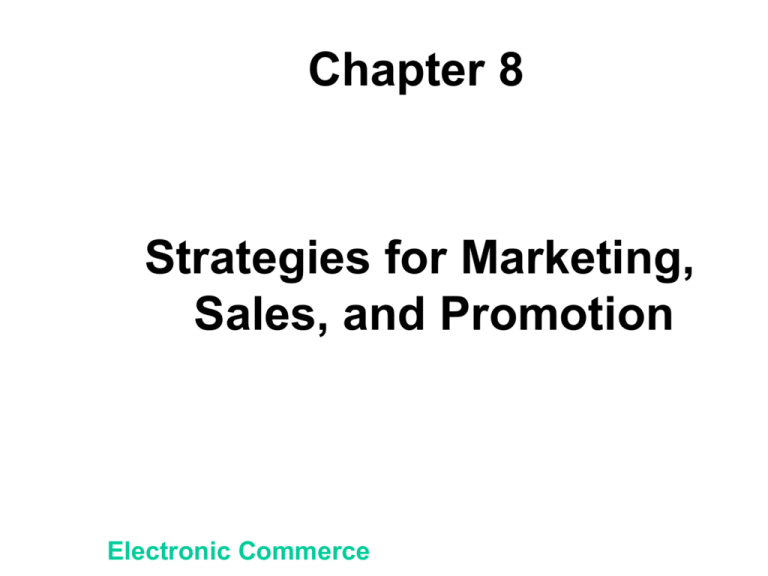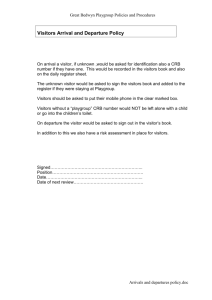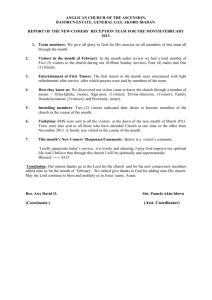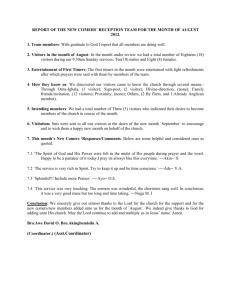MMPC Chapter 8
advertisement

Chapter 8 Strategies for Marketing, Sales, and Promotion Electronic Commerce Objectives Establishing an effective business presence on the Web Web promotion techniques Meeting the needs of web site visitors Web site design usability testing Identifying and reaching customers on the web Objectives Effective Web marketing approaches Elements, strategies, and costs of branding Web business models for selling Creating an Effective Web Presence Presence Public image it conveys to stakeholders Stakeholders Include customers, suppliers, employees, stockholders, neighbors, and the general public Internet increases importance of presence Only contact a customer might have with company is with the company web site Can be critical even for the smallest and newest company Identifying Web Presence Goals A firm’s physical location rarely is image-driven Physical location must satisfy many other business goals unrelated to image and presence Web sites can perform many imageenhancing tasks effectively Businesses must decide which tasks their Web site must accomplish and which tasks are the most important to include Achieving Web Presence Goals Goals associated with effective web sites include: Attracting visitors Making the site interesting to explore Creating a positive image consistent with the company’s desires Reinforcing already held positive images regarding the company Toyota (UK) Web Presence www.toyota.co.uk Toyota (USA) Web Presence www.toyota.com MoMA Web Presence www.moma.org How the Web is Different Companies early in Web history failed to recognize what visitors wanted from Web sites Often failed to include e-mail addresses, telephone numbers and adequate staffing to answer customers’ e-mail messages Web presence should include: History Mission statement Financial and product information Method of contacting the organization Meeting the Needs of Web Site Visitors Why visitors come to Web sites To learn about or buy a company’s products or services Get product support for products already bought Obtain financial or general product information about a company Communicate with the company or identify who manages it Meeting the Needs of Web Site Visitors Web site interface flexibility Versions with and without frames, graphics Multiple information formats Allows users to easily access multiple levels of information detail Access for those with visual disabilities Kodak’s Home Page (USA) www.kodak.com Kodak’s Home Page (UK) www.kodak.co.uk Kodak’s Home Page (HK) www.kodak.com.hk Usability Hints Design the site around how visitors navigate, rather than around the company’s organizational structure Allow quick information access Avoid exaggerated marketing claims Usability Hints Build a site using the oldest browser software on the oldest computer, using the slowest connection, even if that means making multiple versions Be consistent and clear with design and navigation controls Test text and color combinations Mass Media, Personal Contact, and the Web Figure 8-6 Web Terms Used in Marketing A Visit occurs when a visitor requests a page from a web Trial visit First time a visitor loads a web site- after that, it is called a repeat visit Page view Further page loads counted as part of the visit for a time period chosen by the site administrator Each time a visitor loads a page- if the page has an ad, this is called an ad view Impression -- each time a banner ad loads If a visitor clicks the ad to open it, it is called a click or click-through Information Acquisition Approaches: Levels of Trust Figure 8-7 New Marketing Approaches for the Web Traditional mass-market advertising has decreased in effectiveness Advertisers respond through market segmentation Divides the pool of potential customers into common demographic characteristics, such as age, gender, income level, etc. called segments Targets specific messages to these groups Micromarketing- targeting very small market segments Customer Relationship Management Figure 8-8 Amazon Personalised Marketing www.amazon.co.uk Creating and Maintaining Brands on the Web Elements of branding Differentiation Relevance Degree the product offers utility to the customer Perceived value Emotional vs. Rational Branding Emotional appeals work well in mass media because ad targets are passive Do not work well on Web, however, because Web is active medium Rational branding Gives people valuable service in exchange for viewing ads Examples include free e-mail and secure shopping services Other Web Marketing Methods Market leaders can take their dominant positions and extend them to other products and services Expedia, Amazon, Lufthansa, DBRail Affiliate marketing Web site gives product reviews, description, or other information on a product for sale on another site Affiliate site gets commission and has no risk Advertising-Supported Model Used by network television to provide free programming – in USA Problems with this method on the Web: No consensus on how to measure audiences Very few web sites have sufficient visitors to attract large advertisers Monster Careers Page (www.monster.com) Other Market Models on the Web Advertising-subscription Revenue derived from fee for high value information also accepts some level of advertising Used by newspapers and magazines Successful web models include New York Times, the Wall Street Journal, FT, and Reuters Fee mixed model for transaction Model Online travel agents (Expedia, Lufthansa) and car-buying services can remove an intermediary from a value chain Called disintermediation Christmas is Coming! www.presencemall.com Summary Establishing an effective business presence on the Web Web promotion techniques Meeting the needs of web site visitors Web site design usability testing Identifying and reaching customers on the web






